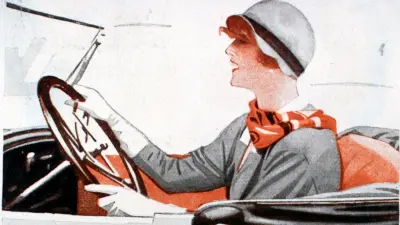The road to Bosch eBike Systems
Interview with two engineers
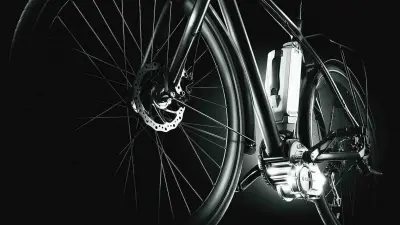
Two minds in pursuit of one and the same idea: The e-bike engineers Peter Kimmich and Philipp Kohlrausch wanted to improve electrically assisted cycling, get more people onto bikes, and make this clever means of transport more popular and universally usable. Fifteen years ago, Bosch eBike Systems started developing the technology.
You hadn’t met when the e-bike drive development project was set up. But nearly two decades ago, both of you were working in the field. How come?
KIMMICH
About 20 or so years ago, I was asked to assess whether it would be worth developing a control unit for e-scooters. It was a very interesting subject, and prompted me to look into the megatrends related to two-wheelers: mobility in growing megacities, an aging society, climate change, and carbon emissions. E-bikes were a perfect fit for all those megatrends!
KOHLRAUSCH
First things first. I’m from Bremen, and we start cycling at an early age there. The conviction that a bicycle is a good way of getting around is deeply seated among the people up there. I stumbled onto the subject of e-bikes when I was offered an opportunity to join a battery project while working in research back in 2006. One aspect of the project was the use of battery technology in electric vehicles: How much electrical energy can I store in a kilogram of batteries, and what is the outlook for the future? The prediction was that lithium-ion could store 200 Wh/kg by 2010. That’s when it hit me: in the foreseeable future, we would be able to make batteries so light that e-bikes wouldn’t be unduly heavy. I thought to myself: That could be the breakthrough!
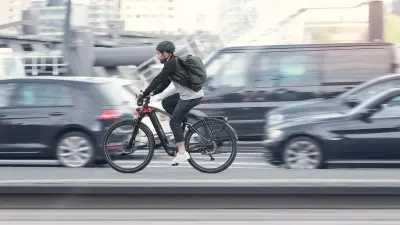
But the idea wasn’t anything new, was it?
KIMMICH
Yamaha already started marketing the kind of e-bike we were thinking of in 1992: a bicycle with assisted propulsion. The control unit registers when the rider starts pedaling hard and delivers additional power, almost imperceptibly. It’s like built-in tailwind, you could say. But no one had thought of developing it for mass-production. Essentially, they were training bikes for physiotherapy centers that had step-through frames, and that were comfortable and designed for people who rarely, if ever, rode a bike. And those bikes were incredibly heavy. Carrying them up or down stairs was impossible.
Yet that still wasn’t the start of your development work?
KOHLRAUSCH
No, but the pieces of the puzzle were coming together.
From a purely technical standpoint, things looked good. I began to think that the steep climb up to our corporate headquarters in Gerlingen could be a good example of what our e-bike is capable of. It’s a climb our board of management is very familiar with. I did a simulation in 2007 and found that you could make the climb two or three times at 300 watt-hours with a battery weight of 2 to 3 kilograms.

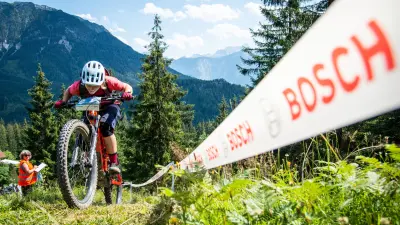
KIMMICH
That must have been around the time when Philipp called me and it became clear that we could combine our two approaches to create a project that made sense. The puzzle is a good visual metaphor: I was the control-unit guy, Phillipp’s background was in battery projects, and we were both involved in motors. In the end, we had a complete system in mind — a motor, battery, and the entire control unit with a user-friendly screen.
KOHLRAUSCH
But there was still a long way to go. Our presentations were beset by setbacks, right up to the prototype that drove off by itself after we switched it on during a demonstration in 2008. It was a demonstration for Volkmar Denner, who was a big proponent of our idea on the board of management. Unfortunately, in the freezing temperatures, the torque sensor we had purchased didn’t work the way it was supposed to, and we had to run after the bike.

That sounds like a disaster. And yet you kept going?
KIMMICH
The funding for our project had been approved. Mr. Denner, who was on the board of management, and Stefan Kampmann, who was in the executive management of Automotive Electronics, supported our efforts. But it was a difficult time. Kampmann told us: “It’s Friday. If you have a solution within a week, you’ll get another chance.”
KOHLRAUSCH
That was the technical side. We had to get a grip on it, and we knew we would. One crucial obstacle was figuring out whether it would even work financially. You had to gauge the real chances on the market: How many bicycles are there, and how many do you need to electrify? What kind of market share do we need in Europe?

And what customers did you have in mind?
KOHLRAUSCH
Bicycle manufacturers. It was going to be a B2B business. We were always very discreet about our market research, but word started getting around that Bosch was up to something. One of the first customers was Cannondale, who — like other manufacturers — gave us suitable frames to build the prototypes around.
KIMMICH
Neither of us had to think about the customers. Another team, headed by Claudia Wasko and Mario Kustosch, was responsible for attracting customers. By mid-2009, we had been able to build prototypes for 14 corporate customers. They were then able to see how good and mature our drive technology was. In 2010, we had our first-ever booth at Eurobike, the leading trade fair for bicycles. We were tucked away in a corner, but our drive unit was the talk of the town. There were a good 50 pre-production bikes featuring our drive units at the trade fair.
That was the beginning. The rest was a success story following all the hard work and extra effort ...
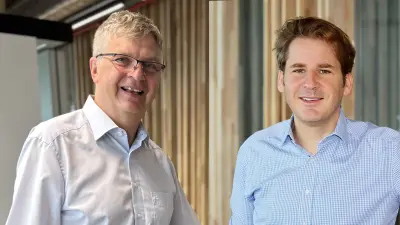
The interviewees
“My name is Peter Kimmich, and I’m a mechanical engineer. I was born in 1963,and have been with Bosch since 1992. I studied mechanical engineering in Stuttgart and had a pretty broad focus, with optics and precision room technology as my main subjects and writing my software-oriented diploma thesis on general gear kinematics. As it turned out, I needed all these disciplines to tackle e-bikes later.”
“My name is Philipp Kohlrausch, and I’m an electrical engineer. I was born in 1975, and joined Bosch in 2000. I studied in Dresden and came to Bosch to work in research, with a focus on modeling, simulation, and control technology. During a battery project, I came to realize that energy density was set to increase so much that lightweight batteries for e-bikes would soon be possible.”
The interview was done by Dietrich Kuhlgatz


